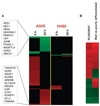Preclinical profile of a potent gamma-secretase inhibitor targeting notch signaling with in vivo efficacy and pharmacodynamic properties
- PMID: 19773430
- PMCID: PMC5260798
- DOI: 10.1158/0008-5472.CAN-09-1843
Preclinical profile of a potent gamma-secretase inhibitor targeting notch signaling with in vivo efficacy and pharmacodynamic properties
Erratum in
- Cancer Res. 2012 Apr 15;72(8):2151
Abstract
Notch signaling is an area of great interest in oncology. RO4929097 is a potent and selective inhibitor of gamma-secretase, producing inhibitory activity of Notch signaling in tumor cells. The RO4929097 IC50 in cell-free and cellular assays is in the low nanomolar range with >100-fold selectivity with respect to 75 other proteins of various types (receptors, ion channels, and enzymes). RO4929097 inhibits Notch processing in tumor cells as measured by the reduction of intracellular Notch expression by Western blot. This leads to reduced expression of the Notch transcriptional target gene Hes1. RO4929097 does not block tumor cell proliferation or induce apoptosis but instead produces a less transformed, flattened, slower-growing phenotype. RO4929097 is active following oral dosing. Antitumor activity was shown in 7 of 8 xenografts tested on an intermittent or daily schedule in the absence of body weight loss or Notch-related toxicities. Importantly, efficacy is maintained after dosing is terminated. Angiogenesis reverse transcription-PCR array data show reduced expression of several key angiogenic genes. In addition, comparative microarray analysis suggests tumor cell differentiation as an additional mode of action. These preclinical results support evaluation of RO4929097 in clinical studies using an intermittent dosing schedule. A multicenter phase I dose escalation study in oncology is under way.
Conflict of interest statement
of Potential Conflicts of Interest No potential conflicts of interest were disclosed.
Figures






References
MeSH terms
Substances
Grants and funding
LinkOut - more resources
Full Text Sources
Other Literature Sources
Molecular Biology Databases

